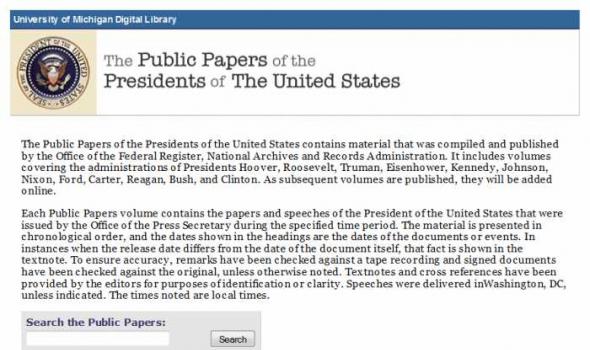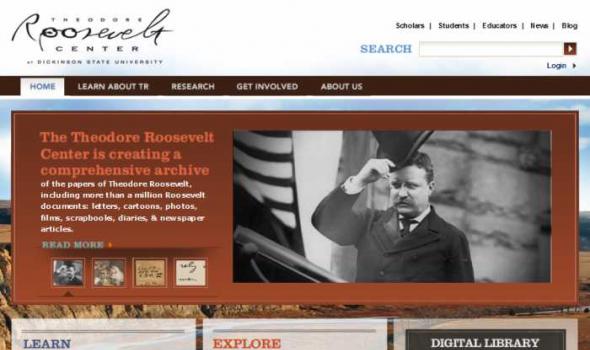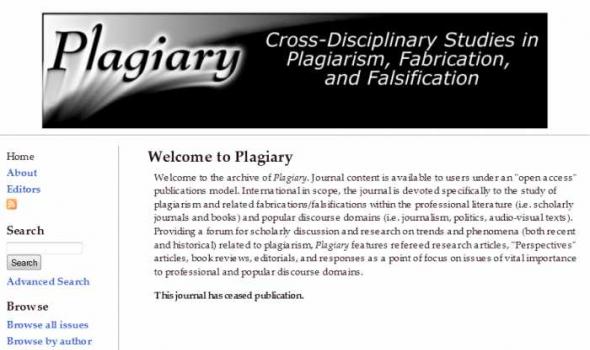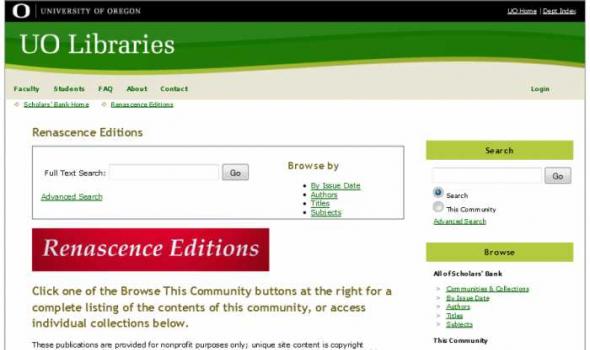American presidents
Abraham Lincoln Association Serials Between 1940 and 1952, the Abraham Lincoln Association published fifty-two issues of The Abraham Lincoln Quarterly , a journal with original articles regarding all facets of Abraham Lincoln's life and the world in which he lived. According to ALA President G. W.
The Public Papers of the Presidents of the United States contains material that was compiled and published by the Office of the Federal Register, National Archives and Records Administration. It includes volumes covering the administrations of Presidents Hoover, Roosevelt, Truman, Eisenhower, Kennedy, Johnson, Nixon, Ford, Carter, Reagan, Bush, and Clinton. As subsequent volumes are published, they will be added online. Each Public Papers volume contains the papers and speeches of the President of the United States that were issued by the Office of the Press Secretary during the specified time period. The material is presented in chronological order, and the dates shown in the headings are the dates of the documents or events.
About About the Lehman Special Correspondence Files The Columbia University Libraries has scanned and made available here electronically the Special Correspondence Files of Herbert Lehman. More than 37,000 documents are included. Typed documents have also been OCRed, permitting full-text searching. The Special Correspondence Files of the Herbert Lehman Papers contain correspondence with nearly 1,000 individuals from 1895 through 1963. Beginning with letters from Lehman's family in the late nineteenth century, the series documents the range and scope of Lehman's long career in public service. Lehman started the series in an attempt to isolate materials he wanted for his own personal use.
Center for Digital Scholarship Box A, Brown University Providence, RI 02912 The Museum Objects of the McLellan Lincoln Collection View into McLellan Lincoln rooms, John Hay Library. A lock of Lincoln’s hair. A hammer owned by John Wilkes Booth. A ruler used by Lincoln in the White House. A cane made from walnut rail split by Lincoln. A block of wood from the house where Thomas Lincoln married his second wife, Sally Johnston. A piece of wallpaper taken from Lincoln’s box at Ford’s Theater. These numinous objects are just a few of the many strange yet fascinating pieces which have found their way into Brown’s McLellan Lincoln Collection. In 1923, John D. Rockefeller Jr. purchased the Charles W.
Here will be preserved all . . . the records that bind State to State and the hearts of all our people in an indissoluble union. --President Herbert Hoover, upon laying the cornerstone of the National Archives Building, February 20, 1933 In 1803 the young republic nearly doubles in size with the Louisiana Purchase. A casualty list of the 54th Massachusetts Infantry Regiment reveals the sacrifices of the most celebrated African-American regiment that fought in the Civil War. A police blotter lists the assassination of President Abraham Lincoln, April 14, 1865.
Here will be preserved all . . . the records that bind State to State and the hearts of all our people in an indissoluble union. --President Herbert Hoover, upon laying the cornerstone of the National Archives Building, February 20, 1933 American Originals presents some of the most treasured documents in the holdings of the National Archives. They have passed through the hands of George Washington, Helen Keller, Wyatt Earp, Napoleon, Rosa Parks, and John Hancock, connecting us physically to another moment in time. While some of the documents announce their own importance with a grand design, others quietly mark a revolution.
"American Originals" is a changing exhibit that has presented the nation's greatest documentary treasures in the Rotunda of the National Archives Building since December 1995. Over the years, the exhibit has featured the first printing of the Declaration of Independence, the police blotter listing Abraham Lincoln's assassination, the first report of the Titanic's collision with an iceberg, Rosa Parks's arrest records, and many other items. Both famous and rare, these documents provide unique insights into the towering figures and events that have shaped U.S. history.
Dear Bess: Love Letters from the President "Dear Bess: Love Letters from the President" February 12, 1998 through September 1, 1999 Garden Room, Truman Library & Museum The Harry S. Truman Library and Museum is one of thirteen Presidential Libraries administered by the National Archives and Records Administration . 500 W. US Hwy. 24. Independence MO 64050 truman.library@nara.gov ; Phone: 816-268-8200 or 1-800-833-1225; Fax: 816-268-8295.
This exhibition examines Presidential elections, with a particular emphasis on elections in the last 80 years when radio and television brought these campaigns into the living rooms of homes across America. Text, photographs, graphic images, original artifacts and campaign memorabilia, as well as audio and video stations will be featured in the exhibition. In addition, a series of activity areas will invite visitors to participate in election activities such as mock voting and campaigning. The exhibition will be organized in a series of theme areas that survey aspects of Presidential campaigns and elections over the years.
National Archives and Records Administraton Eyewitness American Originals from the National Archives Introduction Out of the stacks and vaults of the National Archives comes this selection of eyewitness accounts. They are vivid and intensely personal, transporting us to a deeper understanding of the events described.
The President's Daily Diary: November 22, 1963 - January 20, 1969 The secretaries outside the Oval Office prepared President Johnson's Daily Diary. Juanita Roberts, the President's personal secretary, assigned the responsibility of preparing the Diary to secretaries in the office. A particular person would "work" the Diary for a scheduled period. As visits and telephone calls occurred, the secretary "working" the Diary would note them; occasionally the secretary missed noting a call or meeting. White House staff who worked closely with the President frequently entered the Oval Office without the visit being noted in the Diary.
About This Exhibit Tokens and Treasures Gifts to Twelve Presidents The exhibition "Tokens and Treasures, Gifts to Twelve Presidents" was displayed in the Circular Gallery of the National Archives, March 22, 1996 through February 2, 1997. This exhibit showcases over 200 gifts sent to Presidents Hoover through Clinton.
When Judge John Sirica gaveled the trial of the Watergate seven to order on January 8, 1973, federal investigators had already discovered a covert slush fund used to underwrite nefarious activities against Democrats. The money and the men on trial could be linked to the Committee to Re-elect the President (CRP) at whose head sat the former Attorney General of the United States, and President Nixon’s former law partner, John Mitchell. At the trial, E. Howard Hunt, who had planned the break-in, and four of the burglars pleaded guilty. G. Gordon Liddy, who helped in the planning, and James McCord, the other burglar, refused to cooperate, were convicted of various charges, and sentenced to prison.
Elvis Presley met President Richard Nixon in the Oval Office on December 21, 1970. This is the behind-the-scenes story of how and why the meeting occured told through the original photographs, letters and memos created by Presley and the White House staff.
Thomas Jefferson (1742-1826) was the primary author of the Declaration of Independence (1776), Governor of Virginia (1779-1781), the first Secretary of State (1790-1793), second Vice-President of the United Sates (1797-1801), the third President of the United States (1801-1809), the founder of the University of Virginia (1819), and one of the most influential Founding Fathers. Four letters from the University of Miami Thomas Jefferson collection have been digitized and are available online. A full description and listing of all materials in this collection are available in the Thomas Jefferson (ASM0569) Collection Finding Aid
A century ago, for about 16 hours over April 9th and 10th, 1911, former President Theodore Roosevelt visited the University of Idaho. Roosevelt arrived at 6:30 PM on Sunday, April 9, and took a room at the Hotel Moscow. He woke to rain and clouds the next morning, breakfasted at Ridenbaugh Hall from 7:45 - 8:45 AM " with a large and select party ," planted a tree (that still stands today) in front of the Administration Building, and then spoke, just as the rain stopped, to a reported 8000 people from a platform made of sacks of " North Idaho's famous wheat ." In his speech, Roosevelt mentioned his first visit to Idaho came before any of the students in attendance were born.
New Political Alphabet, or, a Little Book for Great Boys This twenty three page book of alphabet rhymes was published in Windham, Connecticut in 1813, by Samuel Webb. For the letter A: "Great A stands for Adam’s administration and B for betraying the rights of the nation." This rhyme refers to John Adams, the second president of the United States and a conservative Federalist who signed the controversial Alien and Sedition Acts in 1798. Although the New Political Alphabet was published twelve years after Adams left office, the author likely remains anonymous due to the political tone of this rhyme.
In 1861 Abraham Lincoln (1809-1865) became the United States' sixteenth president. But before Lincoln became the nation's chief executive, he led a fascinating life that sheds considerable light upon significant themes in American history. This World Wide Web site presents materials from Lincoln's Illinois years (1830-1861), supplemented by resources from Illinois' early years of statehood (1818-1829). Thus Lincoln/Net provides a record of Lincoln's career, but it also uses his experiences as a lens through which users might explore and analyze his social and political context. How to Use Lincoln/Net: Northern Illinois University Libraries' digitization projects rely upon financial support provided by individual donors, private foundations, and state and federal agencies.
My Collections DIGITAL LIBRARY The Theodore Roosevelt Digital Library includes letters to and from Roosevelt, diary entries, notes, political cartoons, scrapbooks, and more. Timeline Explore the timelines for important dates in TR’s personal and political life, military career, publications, hunting and exploration trips, as well as his time in Dakota Territory. About Us News Explore digital updates, articles and upcoming events. Mission Our goal here at the Theodore Roosevelt Center is to raise the profile of Theodore Roosevelt and to preserve his legacy through events, publications, and the creation of a comprehensive digital presidential library that is freely accessible worldwide via the internet.






































